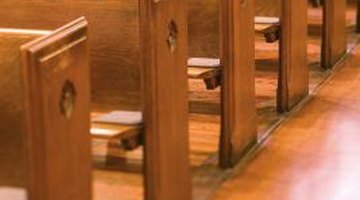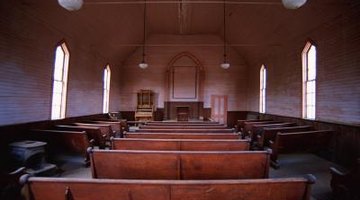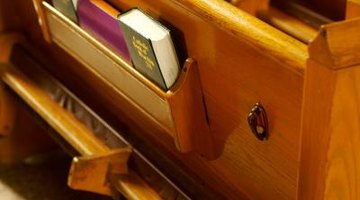Worshippers who attend an older or traditional church usually sit on pews. Pews are long benches arranged in rows facing the altar on either side of a central aisle that leads to the altar. During the medieval period worshippers stood in an open area with a few seats along the walls for the aged and infirm. The trend to seat the entire church congregation began at the end of the medieval period. Pews are traditionally wooden and they consist of several parts.
Pew Ends

Pew ends may be plain and simple or very ornate. Conservative churches might favour pew ends without designs of any kind. Many church pews have routed designs cut into the wood. Ornate pew ends often have elaborate wood carvings on each end Longer pews may have a centre seat support. Craftsmen finish most pews and pew ends with wood stains, but white pew ends are not uncommon.
- Pew ends may be plain and simple or very ornate.
- Craftsmen finish most pews and pew ends with wood stains, but white pew ends are not uncommon.
Backs and Seats

Simple pews have wooden seats and wooden backs that match the pew ends. Where congregations favour some comfort for worshippers, they add a seat pad and sometimes a padded seat back.. Seat and back padding tends to be durable and long-wearing and attractively upholstered in muted colours.
Kneelers

Church pews have integral prayer kneelers for worshippers. The kneeler for each pew attaches to the pew ahead. Some options fix kneelersin place. Many kneelers swing downward on pivoting hardware attached to pew ends and mid-supports. Kneelers usually come padded for comfort with upholstery to match, including back padding.
- Church pews have integral prayer kneelers for worshippers.
Book and Envelope Holders

The back of each pew may have book racks for Bibles and hymnals. Some pews have pockets for offering envelopes with holes for pencils and pens. Craftsmen make racks and pockets of wood to match the pew wood.
Pew Anchors
Pew anchors fix each pew permanently to the floor. Place the L-shaped anchors at pew ends and on either side of pew centre supports. One side of the anchor attaches to the pew with a wood screw. Anchor the pew to the floor with molly bolts fitted through the other side of each anchor.
- Pew anchors fix each pew permanently to the floor.
- Place the L-shaped anchors at pew ends and on either side of pew centre supports.
Front Pews

There is no seat ahead of the front row pews. A special pew front there houses kneelers, book racks and envelope pockets. This pew attaches to the floor with pew anchors at each end and in the centre of the pew front.
